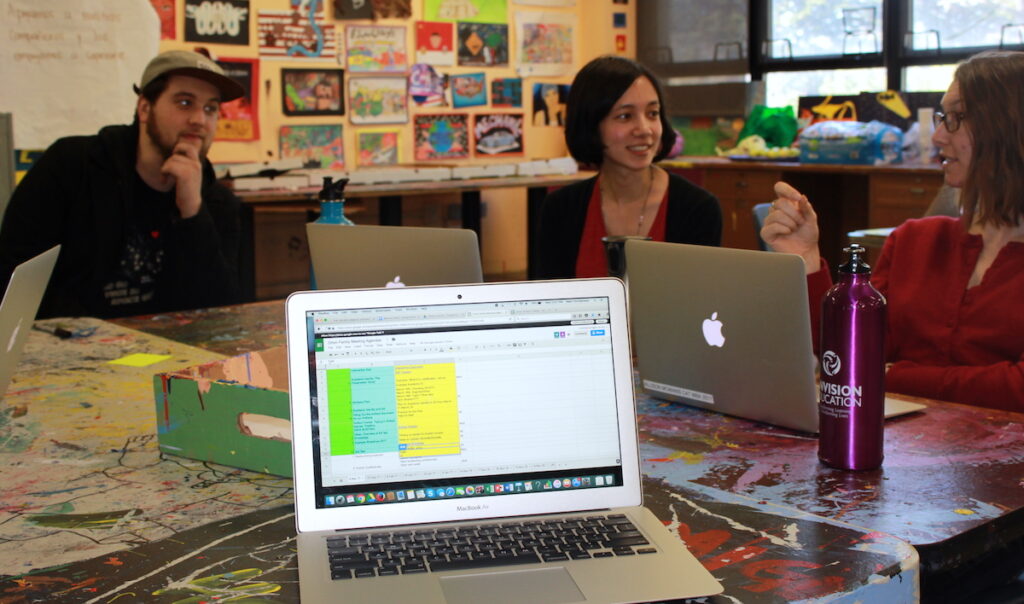Are you looking to lead a professional development meeting with colleagues? Are you feeling uncertain of how to structure the meeting or exactly what you should do? Take a nice, deep breath. We’ve got you covered.
Regardless of the content, here are some key tips to help you lead an effective meeting.
1 .Set the Agenda
The first step in facilitating a productive meeting is to establish a sound agenda. One easy way to do this is to use a spreadsheet application, such as Google Sheets. Using a digital format is helpful so everyone in the meeting can access it at the same time. In addition, it can store notes for future reference.
When setting up the structure for the agenda, four columns titled “Time,” “Topic,” “Description,” and “Notes” work well.
It is also helpful to add a different color to each column to differentiate between them.

- Time
The Time column in the agenda is for you to estimate how much time needs to be given to a specific topic. If your meeting is an hour long, it is essential to make sure the time you assign each topic adds up to one hour. One trick is to always estimate one to two minutes longer than you think you might actually need. You never know when someone will have a lot more to say than you anticipated. - Topic and Description
The topic being discussed and the description of that topic are two different columns. The topic is meant to be a general category of what will be discussed. “Student Talk” or “Check-In Question” is the only information in the topic section on the agenda. Directly beside the topic section is the area for describing what the areas of discussion will revolve around for each topic. For example, if the topic is to discuss advisory for five minutes, the description of that topic would include the key dates, ideas, and questions that will lead the discussion. - Notes
Meetings often yield a lot of important ideas and dialogue. The section for taking notes is a great way to keep track of what was discussed on a particular day. It is especially helpful when using a digital agenda to have a running tab system to compile agendas with. Sometimes staff members will be absent and need to refer to the notes in the agenda. Once in a while, ideas expressed weeks or months ago will be forgotten and need to be revisited. It is a good idea to have notes taken and agendas systematically compiled in the same spreadsheet.
2. Delegate Roles
As the facilitator, you don’t want to be the only one responsible for each part of the meeting. Your job is to guide the conversation and keep people focused on the topic at hand.
Before beginning the meeting, delegate the following roles:
- Time Keeper: This person uses a timer and alerts the group when time is running low. This person is also responsible for telling people when time is up and it’s time to move to the next section of the meeting.
- Note Taker: This person is responsible for taking notes. This person should ask clarifying questions while transcribing to make sure the notes are accurate.
Sharing the tasks allows you to better focus on generating the most vibrant and meaningful discussion possible.

3. Have a Check-In Question
Set a positive tone for the meeting by including a quick check-in question. Check-in questions can be as simple as a favorite movie, something not many people know about you, or one positive student interaction you had this week. Three minutes is plenty of time for a check-in question.
4. Be Prepared
When you facilitate a meeting, you want to save as much time as possible. Making sure you look over the flow of your material and review all accompanying sheets, emails, and documents that will be discussed is important. Inserting links to other spreadsheets, documents, or resources you will expect your team to review together can save time and help keep the momentum going. If you are having colleagues share a best practice or engage in a protocol, be prepared to go first as an example.
5. Send Out the Agenda Ahead of Time
I always appreciate reviewing the agenda of a meeting before the meeting starts. Share the agenda with your colleagues and ask them if there is anything to add. Usually sending the agenda out the day before or the morning of a meeting is sufficient. Our colleagues can often remind us of topics critical to our meeting that were overlooked. Be sure to give staff a chance to chime in beforehand and they may feel more invested in the meeting.
Artist educators are stepping into leadership roles more frequently. Regardless of whether we are leading meetings with other art teachers, other staff, or other adults in general, having a sound structure is essential. Delegating tasks to others in the meeting helps us facilitate, and sharing the agenda with our group in advance can strengthen content and investment. Now is the time. Let’s lead.
What types of structures or styles do you incorporate into PD or staff meetings?
What questions do you have about leading a meeting with a group of colleagues?
Magazine articles and podcasts are opinions of professional education contributors and do not necessarily represent the position of the Art of Education University (AOEU) or its academic offerings. Contributors use terms in the way they are most often talked about in the scope of their educational experiences.





